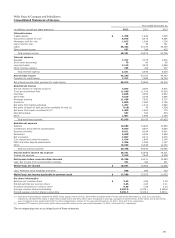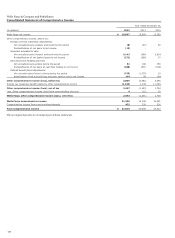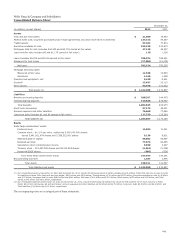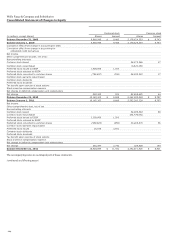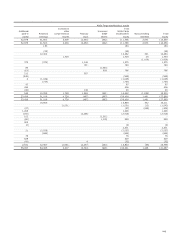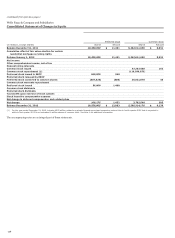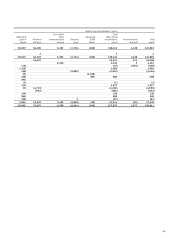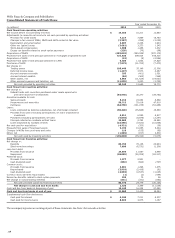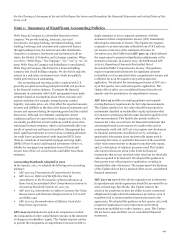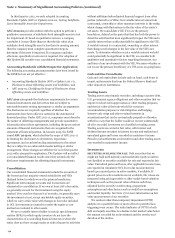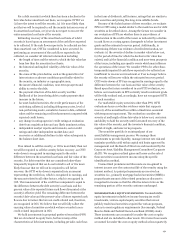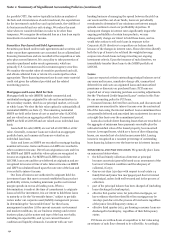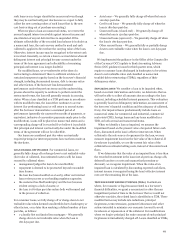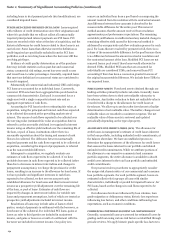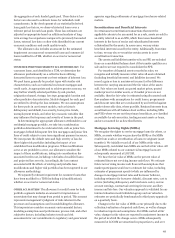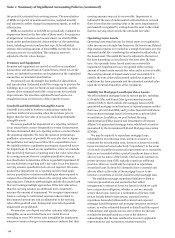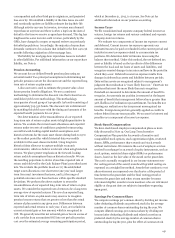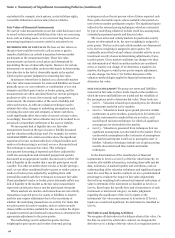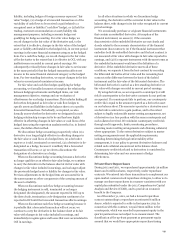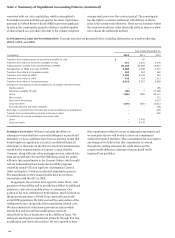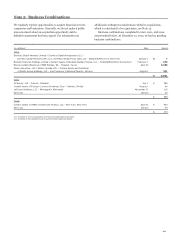Wells Fargo 2012 Annual Report Download - page 133
Download and view the complete annual report
Please find page 133 of the 2012 Wells Fargo annual report below. You can navigate through the pages in the report by either clicking on the pages listed below, or by using the keyword search tool below to find specific information within the annual report. For a debt security for which there has been a decline in the
fair value below amortized cost basis, we recognize OTTI if we
(1) have the intent to sell the security, (2) it is more likely than
not that we will be required to sell the security before recovery of
its amortized cost basis, or (3) we do not expect to recover the
entire amortized cost basis of the security.
Estimating recovery of the amortized cost basis of a debt
security is based upon an assessment of the cash flows expected
to be collected. If the cash flows expected to be collected are less
than amortized cost, OTTI is considered to have occurred. In
performing an assessment of the cash flows expected to be
collected, we consider all relevant information including:
x the length of time and the extent to which the fair value has
been less than the amortized cost basis;
x the historical and implied volatility of the fair value of the
security;
x the cause of the price decline, such as the general level of
interest rates or adverse conditions specifically related to
the security, an industry or a geographic area;
x the issuer's financial condition, near-term prospects and
ability to service the debt;
x the payment structure of the debt security and the
likelihood of the issuer being able to make payments that
increase in the future;
x for asset-backed securities, the credit performance of the
underlying collateral, including delinquency rates, level of
non-performing assets, cumulative losses to date, collateral
value and the remaining credit enhancement compared with
expected credit losses;
x any change in rating agencies' credit ratings at evaluation
date from acquisition date and any likely imminent action;
x independent analyst reports and forecasts, sector credit
ratings and other independent market data; and
x recoveries or additional declines in fair value subsequent to
the balance sheet date.
If we intend to sell the security, or if it is more likely than not
we will be required to sell the security before recovery, an OTTI
write-down is recognized in earnings equal to the entire
difference between the amortized cost basis and fair value of the
security. For debt securities that are considered other-than-
temporarily impaired that we do not intend to sell or it is more
likely than not that we will not be required to sell before
recovery, the OTTI write-down is separated into an amount
representing the credit loss, which is recognized in earnings, and
the amount related to all other factors, which is recognized in
OCI. The measurement of the credit loss component is equal to
the difference between the debt security's cost basis and the
present value of its expected future cash flows discounted at the
security's effective yield. The remaining difference between the
security’s fair value and the present value of future expected cash
flows is due to factors that are not credit-related and, therefore,
are recognized in OCI. We believe that we will fully collect the
carrying value of securities on which we have recorded a non-
credit-related impairment in OCI.
We hold investments in perpetual preferred securities (PPS)
that are structured in equity form, but have many of the
characteristics of debt instruments, including periodic cash flows
in the form of dividends, call features, ratings that are similar to
debt securities and pricing like long-term callable bonds.
Because of the hybrid nature of these securities, we evaluate
PPS for OTTI using a model similar to the model we use for debt
securities as described above. Among the factors we consider in
our evaluation of PPS are whether there is any evidence of
deterioration in the credit of the issuer as indicated by a decline
in cash flows or a rating agency downgrade to below investment
grade and the estimated recovery period. Additionally, in
determining if there was evidence of credit deterioration, we
evaluate: (1) the severity of decline in market value below cost,
(2) the period of time for which the decline in fair value has
existed, and (3) the financial condition and near-term prospects
of the issuer, including any specific events which may influence
the operations of the issuer. We consider PPS to be other-than-
temporarily impaired if cash flows expected to be collected are
insufficient to recover our investment or if we no longer believe
the security will recover within the estimated recovery period.
OTTI write-downs of PPS are recognized in earnings equal to the
difference between the cost basis and fair value of the security.
Based upon the factors considered in our OTTI evaluation, we
believe our investments in PPS currently rated investment grade
will be fully realized and, accordingly, have not recognized OTTI
on such securities.
For marketable equity securities other than PPS, OTTI
evaluations focus on whether evidence exists that supports
recovery of the unrealized loss within a timeframe consistent
with temporary impairment. This evaluation considers the
severity of and length of time fair value is below cost, our intent
and ability to hold the security until forecasted recovery of the
fair value of the security, and the investee's financial condition,
capital strength, and near-term prospects.
The securities portfolio is an integral part of our
asset/liability management process. We manage these
investments to provide liquidity, manage interest rate risk and
maximize portfolio yield within capital risk limits approved by
management and the Board of Directors and monitored by the
Corporate Asset/Liability Management Committee (Corporate
ALCO). We recognize realized gains and losses on the sale of
these securities in noninterest income using the specific
identification method.
Unamortized premiums and discounts are recognized in
interest income over the contractual life of the security using the
interest method. As principal repayments are received on
securities (i.e., primarily mortgage-backed securities (MBS)) a
proportionate amount of the related premium or discount is
recognized in income so that the effective interest rate on the
remaining portion of the security continues unchanged.
NONMARKETABLE EQUITY INVESTMENTS Nonmarketable
equity investments include low income housing tax credit
investments, venture capital equity securities that are not
publicly traded and securities acquired for various purposes,
such as to meet regulatory requirements (for example, Federal
Reserve Bank and Federal Home Loan Bank (FHLB) stock).
These investments are accounted for under the cost or equity
method and are included in other assets. We review those assets
accounted for under the cost or equity method at least quarterly
131


